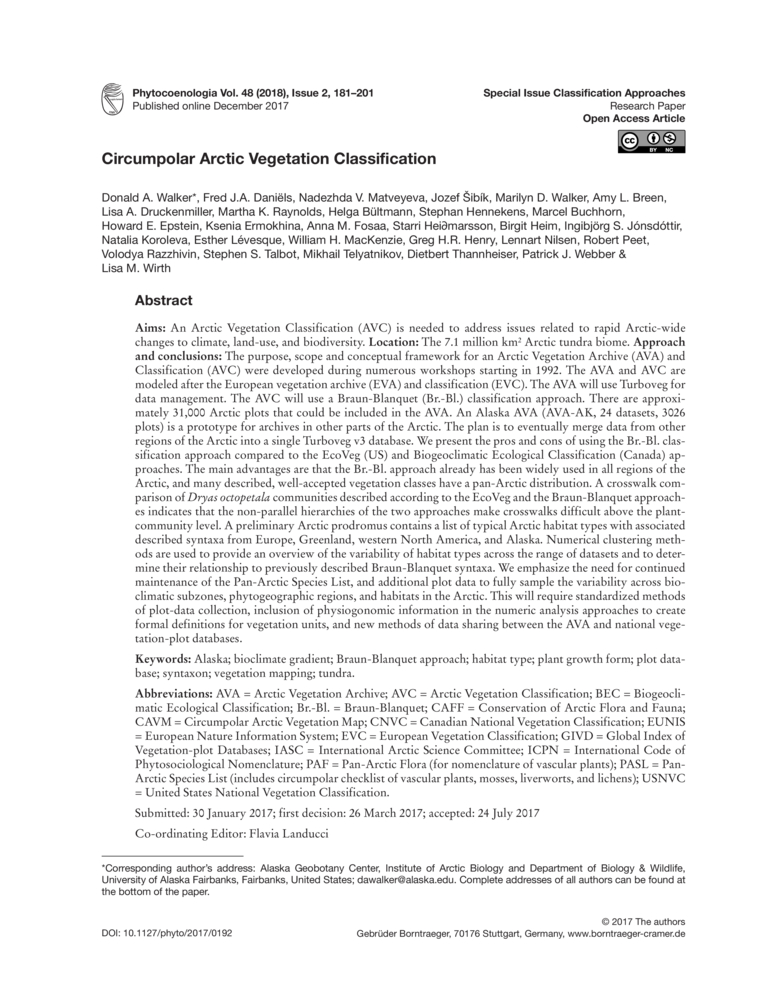Original paper
Circumpolar Arctic Vegetation Classification
Walker, Donald A.; Daniëls, Fred J.A.; Matveyeva, Nadezhda V.; Šibík, Jozef; Walker, Marilyn D.; Breen, Amy L.; Druckenmiller, Lisa A.; Raynolds, Martha K.; Bültmann, Helga; Hennekens, Stephan; Buchhorn, Marcel; Epstein, Howard E.; Ermokhina, Ksenia; Fosaa, Anna M.; Hei∂marsson, Starri; Heim, Birgit; Jónsdóttir, Ingibjörg S.; Koroleva, Natalia; Lévesque, Esther; MacKenzie, William H.; Henry, Greg H.R.; Nilsen, Lennart; Peet, Robert; Razzhivin, Volodya; Talbot, Stephen S.; Telyatnikov, Mikhail; Thannheiser, Dietbert; Webber, Patrick J.; Wirth, Lisa M.

Phytocoenologia Band 48 Heft 2 (2018), p. 181 - 201
129 references
published: May 1, 2018
published online: Dec 15, 2017
manuscript accepted: Jul 24, 2017
manuscript revision received: Jul 17, 2017
manuscript revision requested: Mar 26, 2017
manuscript received: Jan 30, 2017
Open Access (paper may be downloaded free of charge)
Abstract
Abstract Aims: An Arctic Vegetation Classification (AVC) is needed to address issues related to rapid Arctic-wide changes to climate, land-use, and biodiversity. Location: The 7.1 million km2 Arctic tundra biome. Approach and conclusions: The purpose, scope and conceptual framework for an Arctic Vegetation Archive (AVA) and Classification (AVC) were developed during numerous workshops starting in 1992. The AVA and AVC are modeled after the European vegetation archive (EVA) and classification (EVC). The AVA will use Turboveg for data management. The AVC will use a Braun-Blanquet (Br.-Bl.) classification approach. There are approximately 31,000 Arctic plots that could be included in the AVA. An Alaska AVA (AVA-AK, 24 datasets, 3026 plots) is a prototype for archives in other parts of the Arctic. The plan is to eventually merge data from other regions of the Arctic into a single Turboveg v3 database. We present the pros and cons of using the Br.-Bl. classification approach compared to the EcoVeg (US) and Biogeoclimatic Ecological Classification (Canada) approaches. The main advantages are that the Br.-Bl. approach already has been widely used in all regions of the Arctic, and many described, well-accepted vegetation classes have a pan-Arctic distribution. A crosswalk comparison of Dryas octopetala communities described according to the EcoVeg and the Braun-Blanquet approaches indicates that the non-parallel hierarchies of the two approaches make crosswalks difficult above the plant-community level. A preliminary Arctic prodromus contains a list of typical Arctic habitat types with associated described syntaxa from Europe, Greenland, western North America, and Alaska. Numerical clustering methods are used to provide an overview of the variability of habitat types across the range of datasets and to determine their relationship to previously described Braun-Blanquet syntaxa. We emphasize the need for continued maintenance of the Pan-Arctic Species List, and additional plot data to fully sample the variability across bioclimatic subzones, phytogeographic regions, and habitats in the Arctic. This will require standardized methods of plot-data collection, inclusion of physiogonomic information in the numeric analysis approaches to create formal definitions for vegetation units, and new methods of data sharing between the AVA and national vegetation-plot databases. Abbreviation: AVA = Arctic Vegetation Archive; AVC = Arctic Vegetation Classification; BEC = Biogeoclimatic Ecological Classification; Br.-Bl. = Braun-Blanquet; CAFF = Conservation of Arctic Flora and Fauna; CAVM = Circumpolar Arctic Vegetation Map; CNVC = Canadian National Vegetation Classification; EUNIS = European Nature Information System; EVC = European Vegetation Classification; GIVD = Global Index of Vegetation-plot Databases; IASC = International Arctic Science Committee; ICPN = International Code of Phytosociological Nomenclature; PAF = Pan-Arctic Flora (for nomenclature of vascular plants); PASL = Pan-Arctic Species List (includes circumpolar checklist of vascular plants, mosses, liverworts, and lichens); USNVC = United States National Vegetation Classification. Submitted: 30 January 2017; first decision: 26 March 2017; accepted: 24 July 2017
Keywords
Alaska • bioclimate gradient • Braun-Blanquet approach • habitat type • plant growth form • plot database • syntaxon • vegetation mapping • tundra